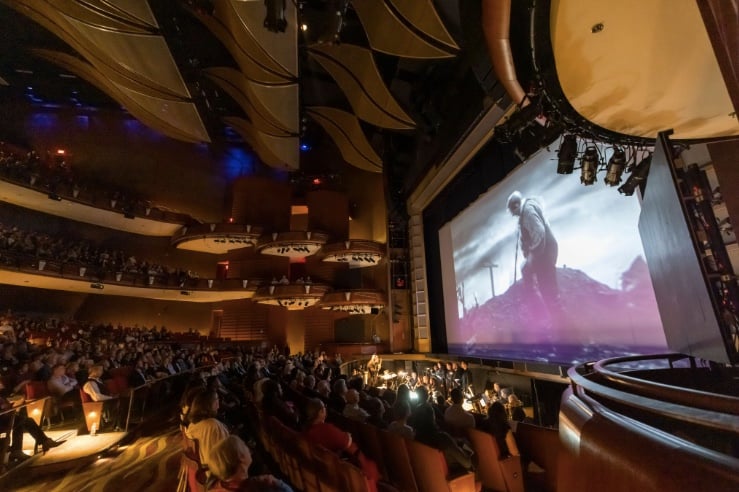Michael Shapiro’s Frankenstein: the Movie Opera is designed to play alongside showings of the 1931 film adaptation starring Boris Karloff. Though originally conceived as an instrumental work, a newly expanded version with vocal accompaniment saw its East Coast premiere Saturday at the Cobb Energy Performing Arts Centre courtesy of The Atlanta Opera.
For the Halloween-costumed audience, it was a fun perspective on a classic of horror cinema. It also provided deep insight into a monstrous character who has staggered and strangled his way into the cultural pantheon.
Although the 1931 film differs wildly from Mary Shelley’s novel, it remains the iteration most closely tied to popular understanding. The culturally ubiquitous image of Frankenstein’s monster, with his bolted neck, flat top hair and poorly fitting black-on-black suit, all originate here. But for all its iconic imagery, the film has no soundtrack as early talkies lacked the necessary second audio track.
The silent backdrop left open a sprawling auditory canvas for a modern composer — but also a challenge: What new insight into the story and its iconic characters would such a score provide?

There is a popular observation about the story of Frankenstein: Intelligence is knowing that Frankenstein was not the name of the monster; wisdom is knowing that Frankenstein was the monster. That dualistic nature between the darkness at the heart of the doctor and the naive innocence of his horrific creation is at the forefront of composer Shapiro’s soundtrack adaptation.
“The monster is the doppelganger of Henry Frankenstein,” says Shapiro, who was present to conduct the orchestra. “There’s even the scene at the end with the rotating wheel where they’re looking at each other.”
Shapiro’s score plums the depths of that mirroring relationship and often willfully defies expectations. The dark and sinister themes that recall Bernard Herrmann’s work on The Twilight Zone are more prominent in scenes that focus on the doctor, while much of the music associated with the monster is gently haunting and at times tender.
“The monster is very sympathetic,” says Shapiro. “Karloff gave him a soul. He’s a creature from various parts that was put together by Henry Frankenstein but he has a soul. How did that happen?”
That soul is accentuated throughout by a soundtrack that ebbs and flows in and out of the film’s spoken dialogue. It is inaccurate to call the work an opera in the purest sense. The newly added voices provided by soprano Amanda Sheriff, contralto Aubrey Odle, tenor Kameron Lopreore and baritone Andrew Gilstrap (all members of the opera’s Glynn Studio Artist program for upcoming singers) aren’t given to specific characters, and they don’t replace the on-screen dialogue. Instead they form a gothic choir around Shapiro’s score with libretto pulled from the traditional Latin requiem mass.
Shapiro’s soundtrack adds a layer that brings a haunting sense of angelic yearning to the score’s dark expanse. When the monster meets a young girl playing by a lake, the delicate weaving of strings and choir make the monster’s moment of friendship and innocent play all the more bittersweet when he inadvertently drowns her.
By contrast, the electrical birthing of the monster and the doctor’s legendary gasp of “It’s alive!” are punctuated by ravenous, swirling minor key melodies and thundering percussion. It leaves no doubt as to which of the two is the truly evil beast. When the monster emerges from behind a rocky outcropping for the final confrontation with his sadistic creator, the anthemic score makes him seem less like an undead monstrosity and more like an avenging angel.

The festive capacity audience seemed unwilling to engage with the deeper implications of Shapiro’s score and was instead more invested in guffawing at the film’s campier moments. Their final round of applause was enthusiastic and seemed sincere, but it was clear that this was a crowd that wanted an experience more akin to the Rocky Horror Picture Show than a work of thoughtful, meditative subtlety.
Ultimately, Shapiro’s truest accomplishment is simply giving the film the soundtrack it always deserved. Modern day avant garde soundtracks for classic silent films and early talkies are nothing new (Philip Glass, The Alloy Orchestra, the Mont Alto Motion Picture Orchestra and many others have been there before), but Shapiro eschews modern stylings and experimentation in favor of understated respect.
The idea of a monster that is too innocent for the evil society surrounding it is a recurring trope in horror cinema. Tim Burton’s Edward Scissorhands (1990), Todd Phillips’ Joker (2019) and many others have offered their own perspectives on the concept. But it arguably begins with Frankenstein. In Frankenstein: the Movie Opera, Shapiro has given that beginning the ominous, harrowing and always intoxicating musical undercurrent it so richly deserves.
::
Jordan Owen began writing about music professionally at the age of 16 in Oxford, Mississippi. A 2006 graduate of the Berklee College of Music, he is a professional guitarist, bandleader and composer. He is currently the lead guitarist for the jazz group Other Strangers, the power metal band Axis of Empires and the melodic death/thrash metal band Century Spawn.

